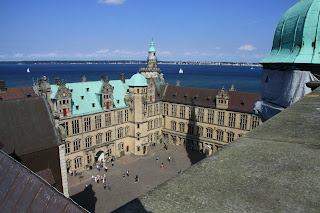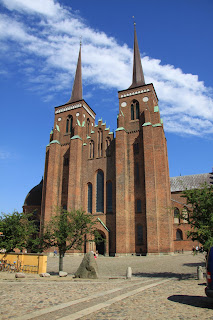Helsingor is a 50-minute train ride from Copenhagen. We walked the old town in the morning before meeting up with our friend Maria from Sweden. We visited an old monastery and enjoyed a latte in a local café.
Once Maria arrived we enjoyed a nice lunch together, then visited the nearby historic Kronborg Castle, a UNESCO World Heritage Site (Phto below left)
Kronborg Castle dates back to the 1430’s, and has been occupied by numerous Kings over the years. Its initial purpose was to control ship traffic to and from the Baltic Sea along a narrow channel between Denmark and Sweden. It was also the setting for Shakespeare’s Hamlet.
Kronborg Castle dates back to the 1430’s, and has been occupied by numerous Kings over the years. Its initial purpose was to control ship traffic to and from the Baltic Sea along a narrow channel between Denmark and Sweden. It was also the setting for Shakespeare’s Hamlet.
When used for this purpose, the King required passing ships to lower a sail in deference to the King’s power and to pay a toll for using the channel. If a ship refused either, a cannon ball was fired ahead of the ships’ bow. If the warning shot was ignored, a second shot was fired intended to hit the ship. Then the ship was required to pay not only the standard toll, but to pay for the cannon ball as well (Photo below right).
Now Jeannie and I never pass an opportunity to climb a tower. Kronborg’s Telegraph Tower was no exception. We climbed the many spiral stairs up several stories to the rooftop for spectacular views back to Helsingor and across the water to Sweden (Photos below).
 |
| Canons positioned to enforce toll collections. |
Now Jeannie and I never pass an opportunity to climb a tower. Kronborg’s Telegraph Tower was no exception. We climbed the many spiral stairs up several stories to the rooftop for spectacular views back to Helsingor and across the water to Sweden (Photos below).
 |
| View of harbor from tower roof. |
 |
| Jeannie on the tower roof. |
 | ||
| View into courtyard from castle tower roof...Sweden beyond | . |
This side visit required another train trip out of Copenhagen…only about 20 minutes. The City of Roskilde is situated in a sheltered bay at the end of a fiord leading to the waters of the Kattegat, and enjoys an important Viking history. Roskilde was the first capital of Denmark and founded by Vikings in the 11th century.
VIKING MUSEUM
We set out to visit both the Viking Museum and Roskilde’s UNESCO Cathedral. The modern Viking Museum was built around the remains of five original Viking ships that had been salvaged by archaeologists in the fiord near Roskilde. The 1,000 year-old ship remains have been carefully excavated and re-assembled in steel frames that re-create the full size and shape of the original ships. (Photos below)

ROSKILDE CATHEDRAL:
The Roskilde Domkirke or Cathedral, built in the 12th century, has been the main burial site for Danish Monarchs since the 15th century (Photo below left). Thirty-eight Danish royalty have been interred here to date, and all their regal coffins are on public display throughout the church. Most of these are quite large and ornate, suggesting the persons popularity and importance in the royalty (Photo below right).
A most unusual coffin has been designed for the current Queen, Margrethe II, and is currently being constructed. It will be partially transparent allowing the interred body to be visible (Photo below). This definitely seems a little gruesome. We can only hope that when it is time for the Queen to join her royal ancestors, her unusual choice of coffins will be viewed favorably by them.
 |
| Queen Margrethe II's planned transparent coffin! |
HILLEROD DAY TRIP – FREDRIKSBORG CASTLE: AUGUST 22nd
The 40-minute train ride to Hillerod took us westerly from Copenhagen, through some beautiful agricultural countryside. More flat land, fields of grain, clusters of farm buildings and small farming communities. The weather this day was ideal; partly sunny, no rain and moderate temperature.
The Fredriksborg Castle is affectionately known as the “The Danish Versailles”. Seems everyone wants to lay claim to having the most palatial castle, symbolic of power and strength! We must admit, though, it IS beautiful. We have toured numerous castles in both France and Germany; Fredriksborg certainly ranks among the best.
The setting for Frederiksborg is spectacular; it sits along a lakeshore, opposite the Hillerod town center and is prominently visible from the town square (Photo below left). Frederiksborg is a Renaissance-style structure dating back to 1560 (Photos below). The castle is now home to a Danish History Museum.
 |
| The castle as seen from Hillerod's central town square. |
The castle’s Great Hall is by far the most extraordinary room; a huge space with tapestry walls, inlaid marble floors and gold-gilded carved ceiling (Photo below left). Paintings, furniture and objects in some rooms exemplify the pompous magnificence of the early period of absolutism. One wing of the castle also is a huge church that now serves Hillerod and surrounding areas, and still retains the private enclosed Royal viewing room opposite the pulpit (Photo below right).

Aside from the remarkable castle, the surrounding gardens are equally incredible. There are actually two very different gardens; the first a huge symmetrical Baroque garden set out on terraces, with a cascading water feature on the central axis, and surrounded by geometric flowerbeds and neatly shaped shrubs and trees. The Baroque style demonstrates how the ideal of the 1700’s was the human desire to control nature (Photo below left).
The Baroque ideal contrasts distinctly with the Romantic style of the second garden. The Romantic style expresses the passion of the 1800’s for free nature; thus, this garden consists of free-growing woodlands, large lawns, lakes, streams and meandering pathways (Photo below right).
 |
| The free-nature garden. |
















